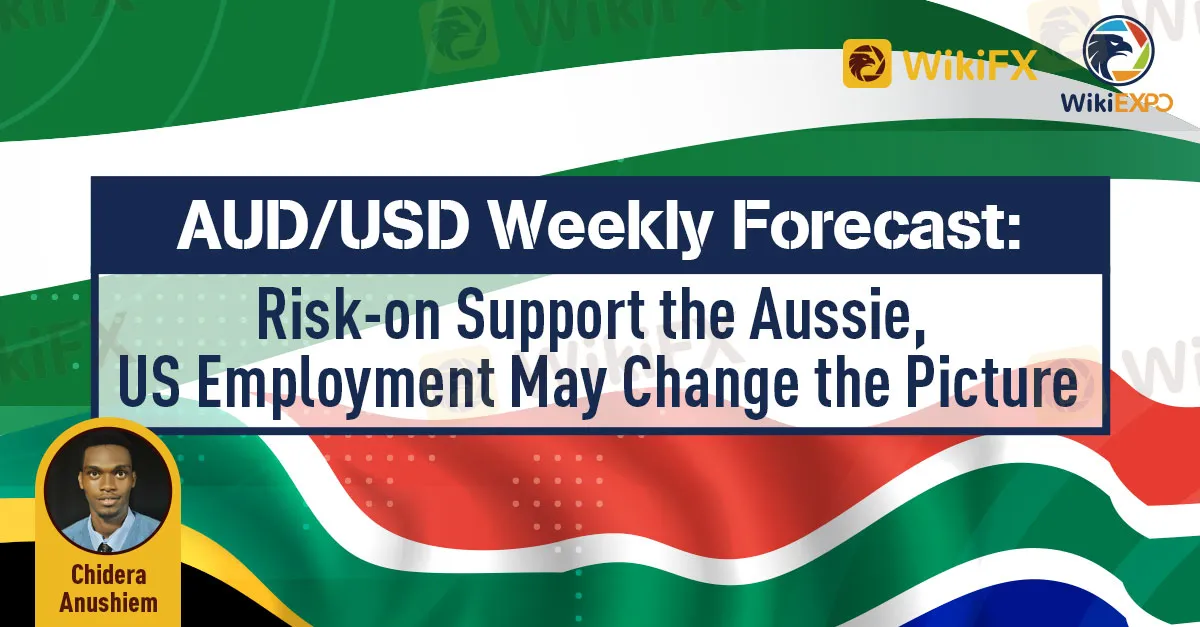简体中文
繁體中文
English
Pусский
日本語
ภาษาไทย
Tiếng Việt
Bahasa Indonesia
Español
हिन्दी
Filippiiniläinen
Français
Deutsch
Português
Türkçe
한국어
العربية
AUD/USD Weekly Forecast: Risk-on Support the Aussie, US Employment May Change the Picture
Abstract:Record highs in Wall Street amid an upbeat mood underpinned the AUD. Softer than anticipated Australian macroeconomic figures capped the upside. AUD/USD modest recovery is not enough to grant further gains ahead.

Record highs in Wall Street amid an upbeat mood underpinned the AUD.
Softer than anticipated Australian macroeconomic figures capped the upside.
AUD/USD modest recovery is not enough to grant further gains ahead.
The AUD/USD pair trades a handful of pips above the 0.7600 level, up for the week after falling to a fresh 2021 low of 0.7476 in the previous one. The pair gained ground on the heels of a generalized positive markets mood.
Generally speaking, macroeconomic data coming from major economies indicated sustained growth, regardless if it missed or surpassed the markets expectations. Central bankers from around the developed world are showing different degrees of optimism regarding the post-pandemic comeback, which is underway.
Markets Rotate Around US Monetary Policy
US Federal Reserve Chair Jerome Powell testified before Congress on Tuesday but had no impact on price action, as he pretty much reiterated what he declared with the FOMC statement.
News that US Congress has agreed on a spending deal further fueled the upbeat sentiment. US President Joe Biden announced on Thursday that a bipartisan deal was reached on Bidens infrastructure plan. The announcement lacked details but was enough to boost equities, with Wall Street ending the week near all-time highs.
Australian data was softer than anticipated, preventing the aussie from posting substantial gains. The preliminary estimate of May Retail Sales printed at 0.1%, down from 1.1% final in April. The June flash Commonwealth Bank PMIs held within expansion territory but contracted from a month earlier.
In the US, macroeconomic figures also missed expectations but were far from concerning. Durable Goods Orders were up 2.3% in May, while the preliminary Markit PMIs resulted above 60 in June, according to preliminary estimates. Initial Jobless Claims for the week ended June 18, printed at 411K. Finally, the Core Personal Consumption Expenditures Price Index jumped to 3.4% YoY as expected in May.
AUD/USD Technical Outlook
The AUD/USD pair has recovered half the ground lost in the previous week, although further gains are still unclear. In the weekly chart, the pair is developing below a flat 20 SMA, which stands at around 0.7710, while the longer moving averages also lack directional strength but far below the current level. Technical indicators have turned modestly higher but remain within negative levels.
On a daily basis, the pair has managed to recover above a flat 200 SMA but remains below the shorter ones, and with the 20 SMA maintaining its bearish slope. Technical indicators corrected oversold conditions from the previous week´s sell-off but remain within negative levels, without strength enough to support continued recovery.
From the current level, supports come in at 0.7530 and 0.7460, followed by the 0.7390 price zone. The immediate resistance level is 0.7620, with a break above it favoring an extension towards the 0.7700 region.

Disclaimer:
The views in this article only represent the author's personal views, and do not constitute investment advice on this platform. This platform does not guarantee the accuracy, completeness and timeliness of the information in the article, and will not be liable for any loss caused by the use of or reliance on the information in the article.
Read more

Trading Psychology – 4 Wise Quotes From The Legendary Mark Douglas
In the world of trading, few books have had the impact of Mark Douglas’ big hit Trading in the Zone. Written almost two decades ago, the book has become a must-read for traders looking to elevate their game to legendary status. While there is so much wisdom to be found in the book, we’ve compiled 5 of the best quotes about trading psychology that every trader should read.

EUR/USD Forecast: New lows ahead of the weekend? ECB, covid and technical all point lower.
Optimism has been weighing on the safe-haven dollar – but not against the euro. The common currency's failure to recover is a sign of weakness that could be followed with falls to fresh lows once the mood sours again – and there are reasons to expect that to happen sooner rather than later.

EURJPY WEEKLY FORECAST. Price Likely To Rise Above 131.000.
The price of EURJPY has been on a steady rise ever since it made a low of 128.808. Other currencies collapsed against the Japanese Yen two weeks ago.

AUD Is Weak Under All-rounded Pressure
A rise in the wake of a fall was seen by DXY last week ascribed to the uncertain time of delisting caused by the Federal Reserve (Fed). However, the reason for the rally of DXY last Friday is the vigorous growth of personal consumption expenditures (PCE) released by the U.S. Bureau of Economic Analysis (BEA).
WikiFX Broker
Latest News
Germany's Election: Immigration, Economy & Political Tensions Take Centre Stage
WikiFX Review: Is IVY Markets Reliable?
Brazilian Man Charged in $290 Million Crypto Ponzi Scheme Affecting 126,000 Investors
ATFX Enhances Trading Platform with BlackArrow Integration
Become a Full-Time FX Trader in 6 Simple Steps
IG 2025 Most Comprehensive Review
Construction Datuk Director Loses RM26.6 Mil to UVKXE Crypto Scam
SEC Drops Coinbase Lawsuit, Signals Crypto Policy Shift
Should You Choose Rock-West or Avoid it?
Scam Couple behind NECCORPO Arrested by Thai Authorities
Currency Calculator







